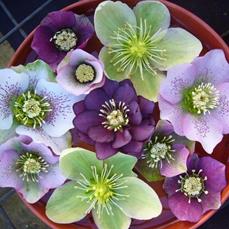
My title is rather misleading. You will have a hard time finding a hellebore plant right now. But this is just to entice you to begin thinking of where you can plant these versatile plants once spring arrives. As part of my goal to have some plant blooming in my yard year-round, I am adding Hellebore. Also known as Christmas Rose or Lenten Rose,
these names give a hint as to when they bloom. Right now, my Helleborus foetidus is producing new leaves and buds that will produce drooping clusters of small, pale green, bell-shaped flowers which contrast with its evergreen foliage. The flowers will last for a long time--into spring. Another name for this hellebore is 'stinking hellebore.' This name is misleading since
the scent is unusual but not objectionable.
 There are many versions of hellebores. A lot of hybridizing is taking place which produces flowers in many colors--white, green, pink and deeper colors such as maroon or spotted flowers. Since most varieties that you buy will re-seed readily and they are already hybrids, you
don't know what color flowers you may get as plants reproduce themselves.
There are many versions of hellebores. A lot of hybridizing is taking place which produces flowers in many colors--white, green, pink and deeper colors such as maroon or spotted flowers. Since most varieties that you buy will re-seed readily and they are already hybrids, you
don't know what color flowers you may get as plants reproduce themselves.
The best way to enjoy these flower blooms is to cut them with about an inch of stem and float them in a shallow bowl of water. They can last for weeks as they slowly fade into completely different colors.
Generally speaking, the flowers droop down on a 45 degree angle. If you aren't familiar with the hellebore, the plants are not very tall--1 1/2 to 2 feet tall so the flowers are close to the ground. The explanation for this unusual form is considering when they bloom. The weather in winter, early spring, and even into late spring is not conducive
to pollination by insects. The flower form is a survival mechanism and the plant's natural defense against snow, sleet, and rain that would destroy the pollen grains and therefore prevent pollination. After all a plant that blooms in late winter has to protect itself since there aren't many pollinators available when the weather is cold. The pollinating insects may have
died or are hibernating. On the occasional warm, sunny day, you will see some early bees or flower flies that take advantage of the few plants that are blooming. Some insects and animals that are available in cold, wet weather are ground beetles, mice, or voles that nest in the ground and scurry under plants to find something to eat. Other early-blooming plants that
benefit from these pollinators are skunk cabbage, woodland wildflowers, and early spring bulbs.
Once the flowers are pollinated the plant will produce seed pods that swell rapidly as the weather warms and then one day they pop open spilling their plump black seeds all over the ground. These seeds contain immature embryos that will mature in the moist warm leaf litter under the parent plant. As the weather turns colder the seeds will
germinate, usually in late December or early January. It takes 2-4 year before you see your first flowers. Another plant to use this system of reproducing is the wildflower, twin leaf (Jeffersonia diphylla). Its single flower produces a seed pod that during the early summer will pop open to spread the seeds.
Here are some facts that you will need to know. They prefer partial to full shade; or plant them under a tree that will provide shade during the hot summer months. Most species bloom somewhere between December to April and will stay in bloom for a month or longer. The foliage remains attractive into summer, so mass plantings are appropriate and
they are ideal for woodland gardens. Rich, moist soil is desirable and they are heavy feeders. Soil pH of 5.5 to 7.0 is fine. There are few pest problems and deer do not like them at all.
There are many companion plants (perennials) to hellebores that also do well in early spring--look for snowdrops (Galanthus), primroses (Primula), foam flowers (Tiarella), barrenwort (Epimediums), and lungwort (Pulmonaria).
Even though it is almost Christmas, there are still plants in the garden that can make you want to walk outside in the cold just to see what is happening to them. It may not be such a barren time of the year after all.
Read other articles on house plants
Read other winter related gardening articles
Read other articles by Martie Young